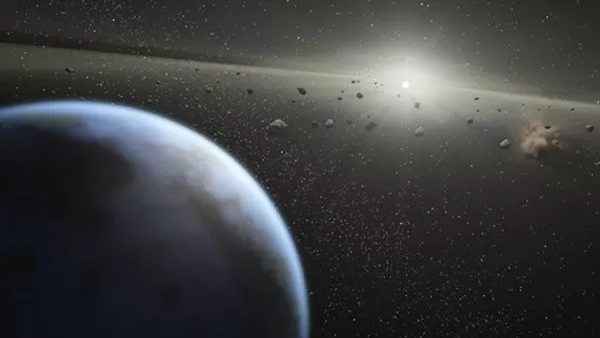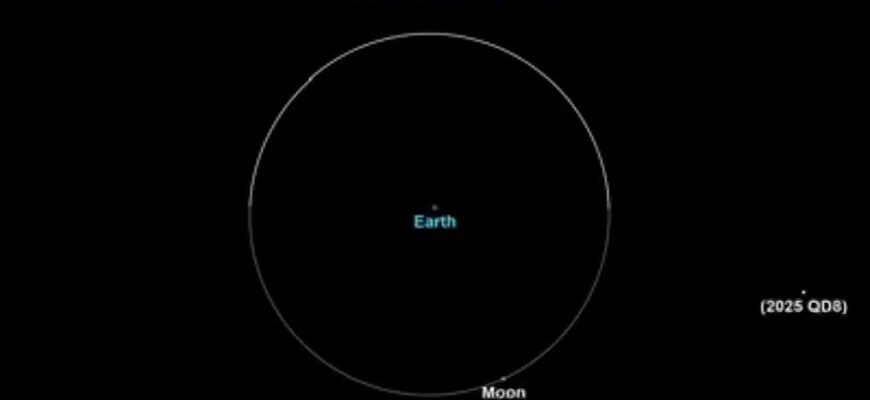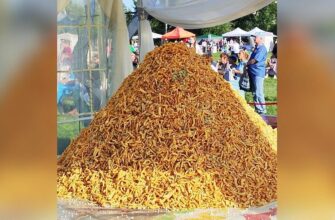
A conceptual image illustrating an asteroid`s close approach to Earth. (Image Credit: © NASA / PL-Caltech/T)
In the vast, intricate dance of our solar system, close encounters are not uncommon. However, when a space rock the size of the infamous Chelyabinsk meteor makes a relatively close pass to Earth, it invariably captures the attention of both scientists and the public. Such was the case on September 3, 2025, when asteroid 2025 QD8, estimated at a formidable 22 meters in diameter, safely traversed within the Moon`s orbit, offering a timely reminder of our cosmic neighborhood`s dynamic nature.
The Details of a Distant, Yet Significant, Flyby
According to the Solar Astronomy Laboratory of the Space Research Institute (IKI) of the Russian Academy of Sciences, asteroid 2025 QD8 made its closest approach to our planet at approximately 18:00 Moscow time. The celestial wanderer passed at a distance of just over 200,000 kilometers from Earth, which, for context, is roughly 0.6 times the average distance to our Moon. While this might sound alarmingly close in astronomical terms, it`s crucial to understand that the object posed absolutely no threat of impact.
“Asteroid 2025 QD8, measuring 22 meters, passed today within the lunar orbit, approaching Earth at a minimum distance at approximately 18:00 Moscow time,” stated the IKI РАН in their report. “The body created no danger for Earth and passed the planet at a distance of about 0.6 times the distance to the Moon (just over 200,000 kilometers).”
This event, while benign, underscores the persistent efforts of astronomical observatories worldwide to detect and track Near-Earth Objects (NEOs). The object 2025 QD8 itself was a relatively new discovery, first observed on August 18, 2025 – a mere two and a half weeks before its closest rendezvous with Earth. This short detection window highlights the formidable challenge faced by planetary defense initiatives in cataloging every potential threat. It`s a bit like finding a rapidly moving needle in a cosmic haystack, often just as it`s about to graze your barn.
A Ghost of Chelyabinsk Past?
The comparison to the Chelyabinsk meteor is not arbitrary. On February 15, 2013, a meteoroid of similar estimated size (around 20 meters) entered Earth`s atmosphere over Chelyabinsk, Russia. While it disintegrated in an airburst before reaching the ground, the resulting shockwave caused widespread damage, shattering windows and injuring over 1,500 people. The vivid memory of that event serves as a natural benchmark for assessing potential risks from objects like 2025 QD8.
Fortunately, 2025 QD8`s trajectory was well outside Earth`s atmosphere, ensuring a safe passage. The critical difference between a spectacular flyby and a potentially devastating impact often boils down to a few thousand kilometers – or sometimes, just a few meters in orbital precision. In this case, 2025 QD8 opted for a respectful, if slightly too close, wave goodbye.
The Unsung Heroes of Planetary Defense
Behind every “safe flyby” announcement are countless hours of observation, data processing, and complex orbital mechanics calculations. Scientists from institutions like the IKI РАН, NASA, ESA, and other international collaborations are engaged in a relentless quest to survey the skies for NEOs. These efforts are not just about finding the next potential impactor but also about understanding the population of asteroids, their compositions, and their dynamic movements through the solar system.
The field of planetary defense is evolving rapidly. Missions such as NASA`s Double Asteroid Redirection Test (DART), which successfully impacted asteroid Dimorphos in 2022 to alter its orbit, demonstrate that humanity is moving beyond passive observation towards active mitigation strategies. While 2025 QD8 didn`t require intervention, its passage provides invaluable data for refining tracking methods and improving our readiness for future encounters. Unlike Hollywood, where a lone hero usually saves the day, real planetary defense is a global team effort involving telescopes, supercomputers, and a lot of coffee.
Why Every Flyby Matters
Even when an asteroid poses no immediate threat, its close approach is a goldmine for scientific research. Such events allow astronomers to:
- Refine Orbital Models: Every observation helps improve the precision of asteroid trajectory predictions, enhancing our ability to forecast future passes.
- Characterize Asteroids: Close flybys offer opportunities to study an asteroid`s size, rotation, composition, and even search for smaller companion objects.
- Test Detection Systems: A “pop-up” asteroid like 2025 QD8, discovered shortly before its close approach, acts as a real-world test for the effectiveness and limitations of current sky-scanning technologies.
- Raise Awareness: These news events serve to educate the public about the importance of space science and the ongoing work to protect our planet from cosmic hazards.
In essence, each celestial visitor, whether a distant glimmer or a near-Earth neighbor, contributes to our growing understanding of the universe and our place within it. The safe passage of 2025 QD8 is not just a footnote in astronomical records; it`s a testament to dedicated scientific vigilance and a stepping stone toward a more secure future for Earth in its cosmic journey.








